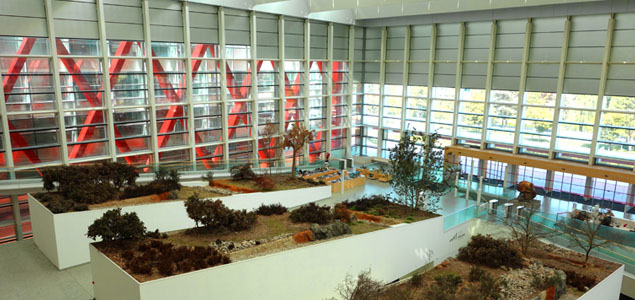Museum of human evolution
This architecture project, designed by the Spanish architect and painter Juan Navarro Baldeweg, is the result of a determine bid of Burgos for modernity. The Museum of Human Evolution is the main building and focal point of the Human Evolution Complex, and it is flanked by the Spanish National Research Centre for Human Evolution (CENIEH) and the Conference and Auditorium Hall “Forum Evolucion Burgos”.
According to Juan Navarro Baldeweg, this Complex explains evolution as a part closely related to the land, the ground, the geological strata and nature in general, which is the reference point for all living species and the receiver of information, containing aknowledge which must be literally excavated.
This architectural project tries to reproduce the Atapuerca Mountains in the city, therefore the access is through a ramp rising five meters above the pavement. This is a small elevation where local vegetation from Atapuerca has been planted, going down in terraces to the river Arlanzon. High from the main entrance a new viewing point of the old town has been created. Once inside the building you get a feeling of continuity, the glass walls keep you connected to the outside area and the adjacent buildings. It is a large box of light which gives a feeling of transparency and opening to society.
There are four sloping modules containing preserved vegetation which help to strengthen the idea of the Mountains; and the lengthwise sections through corridors simulate the Railway cuts carried out to construct the mine railway late 19th century, leading to the discovery of the remains in caves which now help us reconstruct the past.
The MHE, the house of Adán in Burgos

The architect Juan Navarro Baldeweg condenses his idea of the building in one emphatic statement that he wrote in his book, Una Caja de Resonancia. (2007) He says that the constructive dimension is the air itself. Although the words refer to the La Pompa de Jabon, a painting from the eighteenth century by French painter, Jean-Baptiste Siméon Chardin, the phrase succeeds in portraying the Museum of Human Evolution, and the nature of the ethereal architecture that Navarro conceived for the Museum of Human Evolution in Burgos as an almost disembodied case.
Since 2010 the Museum of Human Evolutions poses, among other archaeological treasures of exceptional value, the bones of Homo antecessor, the first known European. The Spanish, European father Adam, lived 800,000 years ago in the Atapuerca Mountains in Burgos. The deposit is inhabited by a Patrimony of Heritage because of the value of the finding relating to our ancestors.
Descubrir El Arte. Continue reading (in Spanish)